
Some of the longest passenger planes in the world are real giants. Right now, the longest plane is the Boeing 747-8 at 250 ft 2 in (76.2 m). Its giant size allows it to accommodate up to 605 passengers, making it one of the largest passenger aircraft in the world.
It is followed by the Airbus A340-600, a rare quadjet today but once a staple of the long-haul scene, with its 247 ft 3 in (75.3 m) fuselage just a few feet shorter than the 747-8.
And in bronze position is the enigmatic Boeing 777-300 at 242 ft 4 in (73.8 m) , with several other famous faces in the top 10.
 Photo: By Duan Zhu – http://www.airliners.net/photo/Air-France/Boeing-777-328-ER/1964624/L/, CC BY 3.0, https://commons.wikimedia.org/w/index.php?curid=20580763
Photo: By Duan Zhu – http://www.airliners.net/photo/Air-France/Boeing-777-328-ER/1964624/L/, CC BY 3.0, https://commons.wikimedia.org/w/index.php?curid=20580763Top 10 Longest Passenger Planes
The evolution of aircraft length reflects technological advancements and changing airline preferences. Modern long-haul aircraft aim to balance maximum capacity, extended range, and fuel efficiency, while navigating increasingly tight operating margins.
Below is an in-depth look at the ten longest passenger aircraft ever manufactured, ordered by their total fuselage length.
| 1 | Boeing 747-8 | 250 ft 2 in, 76.2 | June 2012 | Lufthansa, Korean Air, Air China | 605 | 7,730 |
| 2 | Airbus A340-600 | 247 ft 3 in, 75.3 | August 2002 | Lufthansa, Mahan Air, Hi Fly | 440 | 7,500 |
| 3 | Boeing 777-300 | 242 ft 4 in, 73.8 | May 1998 | Emirates, Qatar Airways, Cathay | 550 | 7,370 |
| 4 | Airbus A350-1000 | 242 ft 2 in, 73.7 | February 2018 | Qatar Airways, Cathay Pacific | 480 | 8,700 |
| 5 | Airbus A380 | 238 ft 7 in, 72.6 | October 2007 | Emirates, Singapore Airlines | 853 | 8,000 |
| 6 | Boeing 747-400 | 231 ft 10 in, 70.4 | February 1989 | Lufthansa, Rossiya | 660 | 7,285 |
| 7 | Boeing 787-10 | 224 ft, 68.3 | March 2018 | Singapore Airlines, United | 440 | 6,330 |
| 8 | Airbus A340-500 | 222 ft 10 in, 67.7 | October 2003 | Azerbaijan Airlines, Sands Aviation | 440 | 9,000 |
| 9 | Airbus A350-900 | 219 ft 2 in, 66.76 | January 2015 | Singapore Airlines, Qatar Airways | 440 | 8,100 |
| 10 | Boeing 777-200 | 209 ft 1 in, 63.7 | June 1995 | United Airlines, British Airways | 440 | 5,240 |
 Photo: By Curimedia | P H O T O G R A P H Y – Boeing 747-830 Lufthansa D-ABYKUploaded by Dura-Ace, CC BY 2.0, https://commons.wikimedia.org/w/index.php?curid=29924639
Photo: By Curimedia | P H O T O G R A P H Y – Boeing 747-830 Lufthansa D-ABYKUploaded by Dura-Ace, CC BY 2.0, https://commons.wikimedia.org/w/index.php?curid=299246391. Boeing 747-8
- Length (ft/m): 250 ft 2 in / 76.2 m
- Entry into Service: June 2012
- Passenger Capacity: 605
- Range: 7,730 nmi
The Boeing 747-8 Intercontinental is the longest passenger aircraft currently in service. Designed as a modern evolution of the iconic 747 series, it features improved aerodynamics, lighter materials, and quieter engines derived from the Boeing 787 Dreamliner.
Despite its impressive size and advanced capabilities, sales were limited due to the aviation industry’s shift toward more fuel-efficient twinjets such as the Boeing 777 and Airbus A350.
Production ended in 2022 following a lukewarm market reception. Lufthansa (LH), Korean Air (KE), and Air China (CA) are the primary commercial operators.
The 747-8 also remains in service for VIP and government transport, including the forthcoming VC-25B, the next-generation Air Force One.
While it currently holds the title of the world’s longest passenger jet, the Boeing 777-9 is expected to surpass it when it enters service.
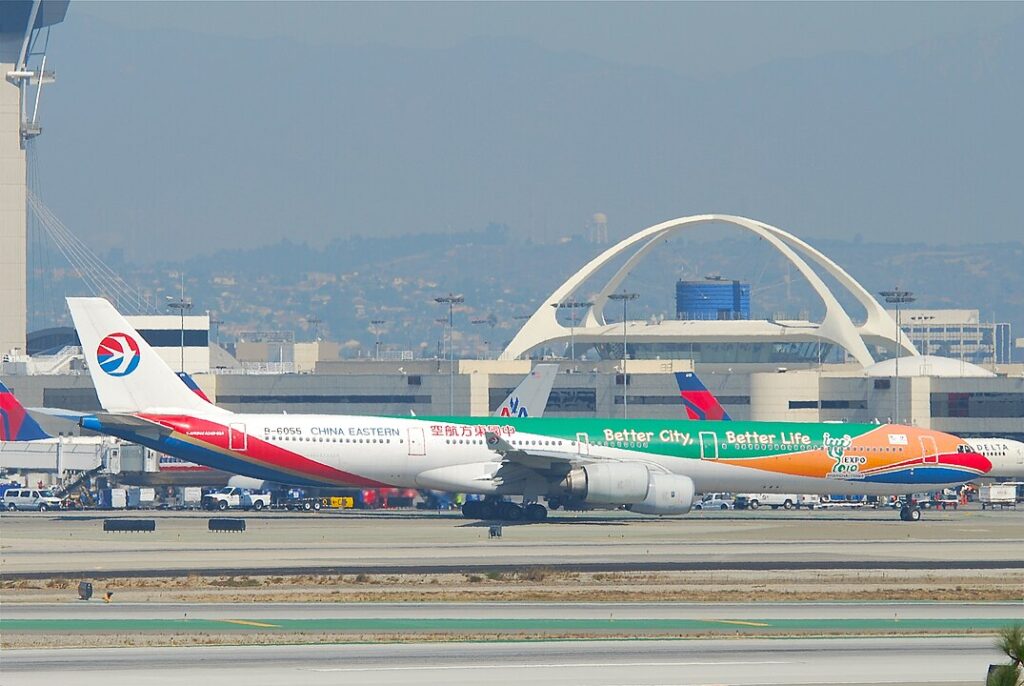 Photo: By Aero Icarus from Zürich, Switzerland – China Eastern Airlines Airbus A340-600; B-6055@LAX;11.10.2011/623fv, CC BY-SA 2.0, https://commons.wikimedia.org/w/index.php?curid=26712319
Photo: By Aero Icarus from Zürich, Switzerland – China Eastern Airlines Airbus A340-600; B-6055@LAX;11.10.2011/623fv, CC BY-SA 2.0, https://commons.wikimedia.org/w/index.php?curid=267123192. Airbus A340-600
- Length (ft/m): 247 ft 3 in / 75.3 m
- Entry into Service: August 2002
- Passenger Capacity: 440
- Range: 7,500 nmi
The Airbus A340-600 was once the longest commercial aircraft in the world, a title it held until the introduction of the Boeing 747-8.
Powered by four Rolls-Royce Trent 500 engines, it offered exceptional range and stability on ultra-long-haul routes.
Airlines such as Lufthansa (LH) and Virgin Atlantic operated this quadjet on high-capacity transcontinental flights.
However, its popularity declined due to rising fuel costs and the increased maintenance complexity compared to more efficient twinjets like the Boeing 777-300ER and Airbus A350-1000.
Only 97 units were produced before production ended in 2011. According to Business Insider, Lufthansa plans to retire its last A340-600 by October 2025. A few remain in service in VIP or government roles, including in countries such as Iran, Venezuela, and Portugal.
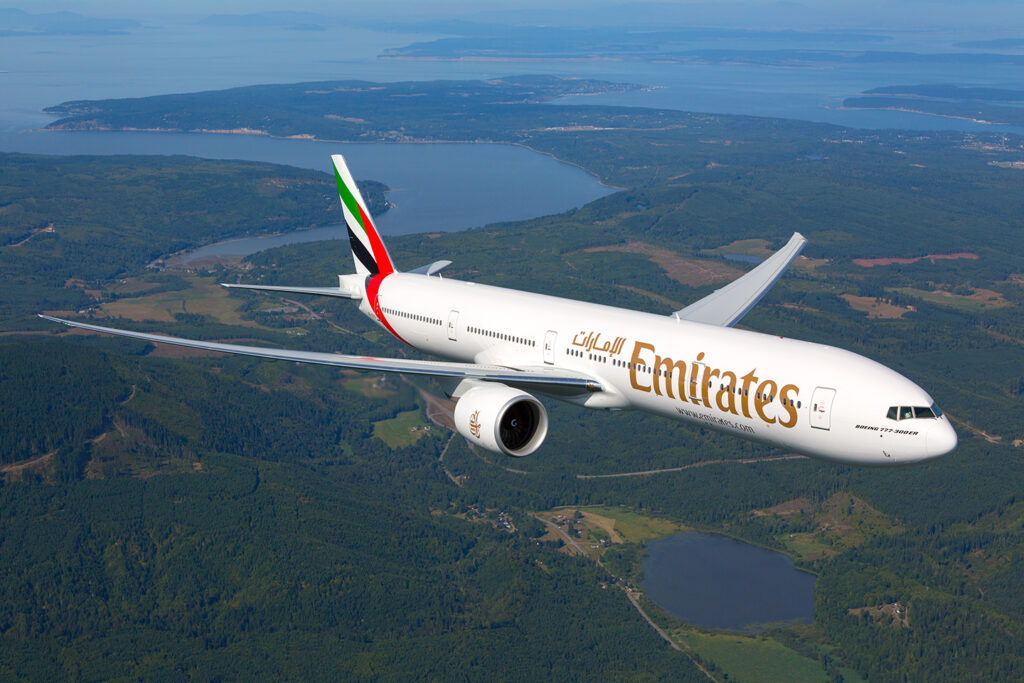 Photo by Emirates
Photo by Emirates3. Boeing 777-300
- Length (ft/m): 242 ft 4 in / 73.8 m
- Entry into Service: May 1998
- Passenger Capacity: 550
- Range: 6,030–7,370 nmi
The Boeing 777-300 is a versatile widebody jet that played a pivotal role in the long-haul segment. Introduced in 1998, it was later upgraded to the 777-300ER, which went on to become one of Boeing’s best-selling aircraft.
Airlines such as Emirates (EK), Qatar Airways (QR), and Cathay Pacific (CX)Cathay pacific have relied heavily on this variant for high-capacity international routes.
With over 800 units delivered, the 777-300 series stands as a testament to adaptability and reliability. It held the title of the world’s longest airliner for four years before being surpassed by the Airbus A340-600.
While newer models like the Boeing 777X will exceed it in length and capability, the 777-300 remains a cornerstone of many global carriers’ fleets.
 Photo: Clément Alloing
Photo: Clément Alloing4. Airbus A350-1000
- Length (ft/m): 242 ft 2 in / 73.7 m
- Entry into Service: February 2018
- Passenger Capacity: 480
- Range: 8,700 nmi
The Airbus A350-1000 is the flagship of Airbus’s widebody fleet, offering exceptional efficiency and long-range capability.
Slightly shorter than the Boeing 777-300, it compensates with advanced composite materials and next-generation engines, making it highly fuel-efficient.
The aircraft typically seats between 350 and 410 passengers, with a maximum capacity of up to 480.
Its impressive 8,700 nautical mile range allows for non-stop service on some of the world’s longest routes, including Qantas’s upcoming Project Sunrise flights connecting Australia to London (LHR) and New York (JFK).
Major operators such as Qatar Airways (QR), Cathay Pacific (CX), and British Airways (BA) continue to invest in the A350-1000.
With strong performance and rising demand, the A350-1000 is well-positioned as a direct competitor to the forthcoming Boeing 777-9.
 Photo: Clément Alloing
Photo: Clément Alloing5. Airbus A380
- Length (ft/m): 238 ft 7 in / 72.6 m
- Entry into Service: October 2007
- Passenger Capacity: 853
- Range: 8,000 nmi
The Airbus A380 is the largest passenger aircraft ever built, featuring a full-length double-deck cabin that offers unparalleled space and luxury.
With a maximum capacity of 853 passengers, no airline has configured it in an all-economy layout; typical configurations accommodate around 550 passengers.
Emirates (EK), Singapore Airlines (SQ), and British Airways (BA) are among the primary operators, utilizing the A380 for high-density, long-haul routes.
Its impressive 8,000 nautical mile range enables the efficient transportation of large passenger volumes across continents.
However, due to operational inefficiencies and declining demand for very large aircraft, production ended in 2021 after the delivery of 251 units.
Despite this, major carriers like Emirates plan to continue operating their A380 fleets well into the 2030s.
 Photo: By Aero Icarus from Zürich, Switzerland – Lufthansa Boeing 747-400; D-ABTA@BKK;29.07.2011/612bn, CC BY-SA 2.0, https://commons.wikimedia.org/w/index.php?curid=26714287
Photo: By Aero Icarus from Zürich, Switzerland – Lufthansa Boeing 747-400; D-ABTA@BKK;29.07.2011/612bn, CC BY-SA 2.0, https://commons.wikimedia.org/w/index.php?curid=267142876. Boeing 747-400
- Length (ft/m): 231 ft 10 in / 70.4 m
- Entry into Service: February 1989
- Passenger Capacity: 660
- Range: 7,285 nmi
The Boeing 747-400 was the pinnacle of the 747 series before being succeeded by the 747-8 Intercontinental.
Renowned for its iconic hump and four-engine configuration, it revolutionized long-haul travel with its spacious interior and extended range.
Airlines such as Lufthansa (LH) and Rossiya Airlines once operated it in premium-heavy configurations.
Although it could carry up to 660 passengers, most airlines opted for mixed-class layouts accommodating approximately 400 to 450 passengers.
With a range of 7,285 nautical miles, it was ideal for transoceanic routes. Production ceased in 2005, and only a few remain in passenger service today.
Some have been converted for cargo use, while others serve specialized roles, such as the US presidential aircraft, Air Force One.
 Photo: Utkarsh Thakkar (Vimanspotter)
Photo: Utkarsh Thakkar (Vimanspotter)7. Boeing 787-10
- Length (ft/m): 224 ft / 68.3 m
- Entry into Service: March 2018
- Passenger Capacity: 440
- Range: 6,330 nmi
The Boeing 787-10 Dreamliner is the largest variant of the 787 family, designed for high-efficiency, short- to medium-range operations.
Measuring 224 feet in length, it bridges the gap between the smaller 787-9 and traditional widebodies like the Boeing 767 and 777-200.
With a capacity of up to 440 passengers, it is commonly used on dense domestic and regional international routes.
Its range of 6,330 nautical miles supports both transcontinental and intercontinental flights, although it lacks the endurance of ultra-long-range jets.
Key operators include Singapore Airlines (SQ), United Airlines (UA), British Airways (BA), Etihad Airways (EY), and Air France–KLM (AF/KL).
To date, over 117 units have been delivered, with 263 orders placed. Etihad Airways operates a special sustainability-focused version known as the “Greenliner.”
 Photo: By Laurent ERRERA from L’Union, France – Airbus A340-500 Emirates (UAE) A6-ERG – MSN 608, CC BY-SA 2.0, https://commons.wikimedia.org/w/index.php?curid=29839059
Photo: By Laurent ERRERA from L’Union, France – Airbus A340-500 Emirates (UAE) A6-ERG – MSN 608, CC BY-SA 2.0, https://commons.wikimedia.org/w/index.php?curid=298390598. Airbus A340-500
- Length (ft/m): 222 ft 10 in / 67.7 m
- Entry into Service: October 2003
- Passenger Capacity: 440
- Range: 9,000 nmi
The Airbus A340-500 was once the world’s longest-range passenger aircraft, capable of flying 9,000 nautical miles on ultra-long-haul routes such as Singapore (SIN) to Newark (EWR).
Powered by four Rolls-Royce Trent 553 engines, it offered exceptional endurance but was hampered by high fuel consumption compared to more efficient modern twinjets.
Only 34 units were produced, with Emirates (EK) as the largest former operator. Today, regular passenger service is virtually nonexistent, with the last two aircraft, operated by Azerbaijan Airlines, having been parked since 2023.
Several governments and VIP operators, including those of Kuwait, Thailand, and Qatar, continue to use the A340-500 for executive transport. Sands Aviation also operates one for shuttling high-profile clients around the globe.
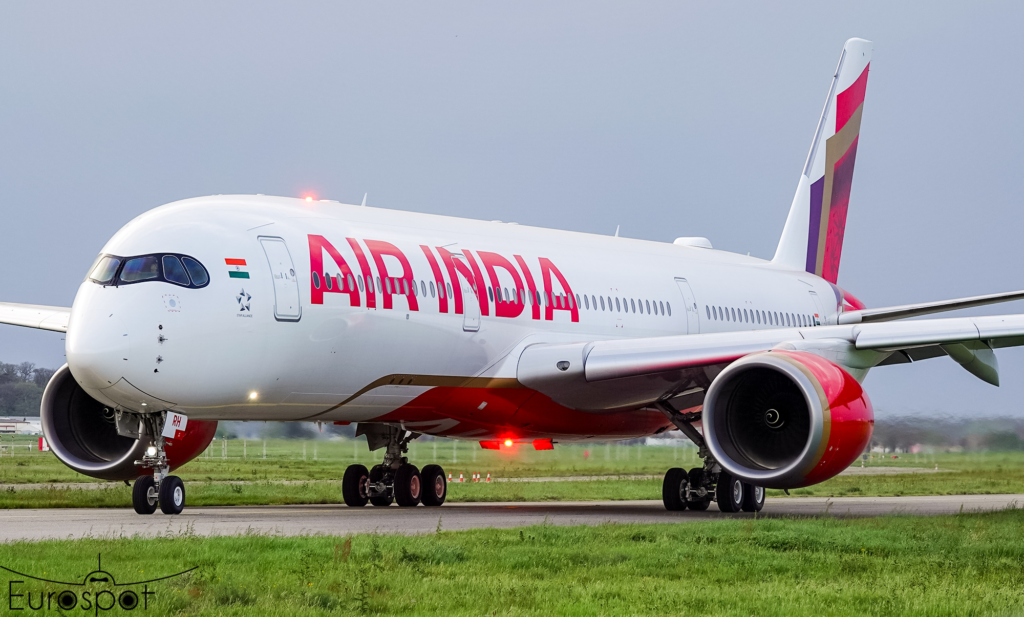 Photo: Eurospot
Photo: Eurospot9. Airbus A350-900
- Length (ft/m): 219 ft 2 in / 66.76 m
- Entry into Service: January 2015
- Passenger Capacity: 440
- Range: 8,100 nmi
The Airbus A350-900 serves as the workhorse of the A350 family, offering an optimal balance of range, efficiency, and passenger comfort. With a fuselage measuring 219 feet 2 inches, it comfortably accommodates 300–400 passengers in standard configurations, with a maximum capacity of 440.
Its 8,100 nautical mile range makes it well-suited for both long-haul and medium-range operations. Major operators include Singapore Airlines (SQ), Qatar Airways (QR), Cathay Pacific (CX), and Air France (AF).
As of 2024, over 548 units have been delivered out of 989 ordered, making it the most popular variant in the A350 lineup.
Singapore Airlines also operates a specialized Ultra Long Range version for non-stop flights between Singapore (SIN) and New York (JFK), featuring exclusive business and premium economy seating.
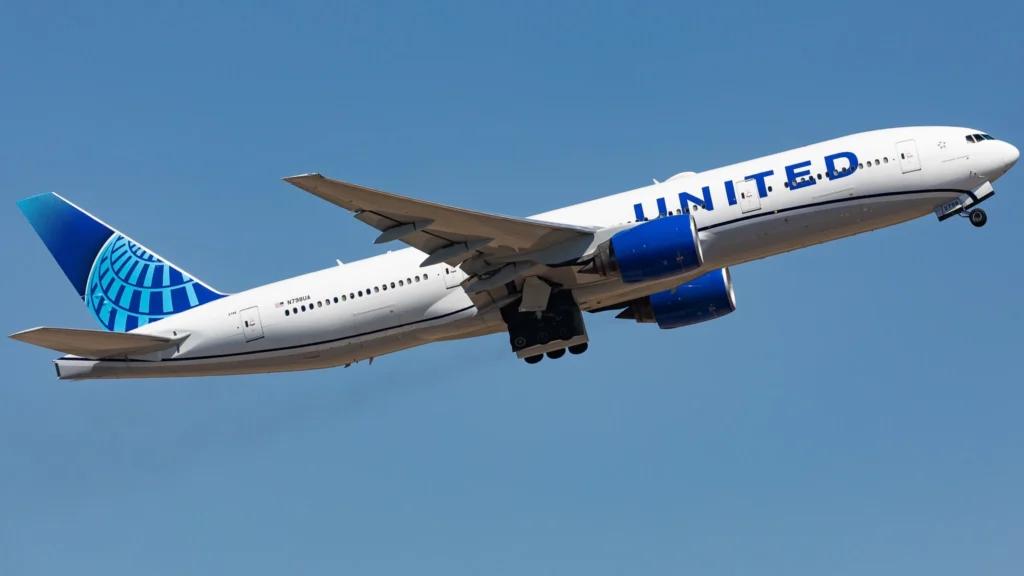 Photo: Clément Alloing
Photo: Clément Alloing10. Boeing 777-200
- Length (ft/m): 209 ft 1 in / 63.7 m
- Entry into Service: June 1995
- Passenger Capacity: 440
- Range: 5,240 nmi
The Boeing 777-200 was the first member of the successful 777 family, introduced in 1995 with United Airlines (UA). It set a new standard for twin-engine widebodies with advanced fly-by-wire controls and powerful GE90 engines.
With a capacity of up to 440 passengers, it was widely used on medium- to long-haul routes. The 777-200ER variant extended its range to 7,065 nautical miles, making it one of the most versatile aircraft in aviation history.
Over 800 units of the entire 777 family have been delivered, with legacy operators including British Airways (BA), American Airlines (AA), ANA, and Japan Airlines (JL).
Although newer models like the 777-300ER and 777X have taken precedence, the original 777-200 remains in service with several carriers worldwide.
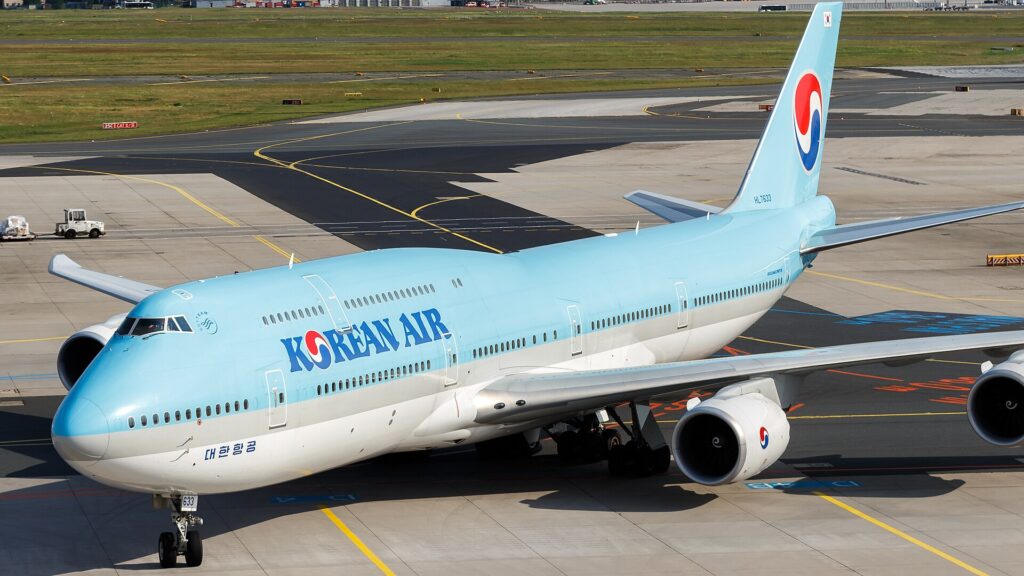 Photo: By tjdarmstadt – IMG_8483.jpg, CC BY 2.0, https://commons.wikimedia.org/w/index.php?curid=61529842
Photo: By tjdarmstadt – IMG_8483.jpg, CC BY 2.0, https://commons.wikimedia.org/w/index.php?curid=61529842Bottom Line
The dominance of quadjets such as the Boeing 747 and Airbus A340 has steadily declined due to rising fuel costs and maintenance complexities.
Twinjets like the Airbus A350 and Boeing 787 have taken over long-haul operations thanks to their superior economics and performance.
For example, the Airbus A350-1000, measuring 242 feet 2 inches in length, offers unmatched range and efficiency, enabling airlines to operate non-stop services between distant hubs like New York (JFK) and Singapore (SIN).
Similarly, the Boeing 787-10 serves high-density short- to medium-haul routes, complementing the larger 777 family.
Stay tuned with us. Further, follow us on social media for the latest updates.
Join us on Telegram Group for the Latest Aviation Updates. Subsequently, follow us on Google News
Top 10 Biggest Airplanes in the World (Updated)
The post Longest Passenger Planes in the World, No.2 Will Surprise You appeared first on Aviation A2Z.


















